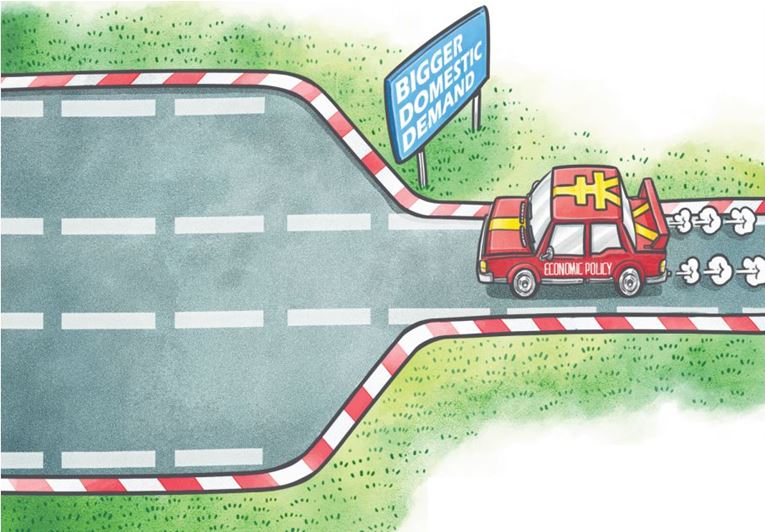Proactive moves, larger demand key to growth


There is little doubt that China's full-year economic growth rate will exceed 6 percent year-on-year in 2021.
Although China has essentially brought COVID-19 under control domestically, and the nation's economic recovery occurred earlier than elsewhere, it has not yet reversed a continuous economic growth downtrend first seen around 2010.
Following that trend, we are concerned over whether China's economic growth will be even weaker next year.
The National Bureau of Statistics said that in the first and second quarters of 2021, the year-on-year real GDP growth rate reached 18.3 percent and 7.9 percent, respectively. The rates were lower than expected levels given an assumption that the country's potential full-year economic growth rate is 6 percent.
Under that assumption, taking the GDP level in the fourth quarter of 2019 before the outbreak of the pandemic as the starting point, the first quarter real GDP growth rate should be 19.1 percent, and the rate for the second quarter should be 8.3 percent at least to make sure growth returns to pre-pandemic levels.
Thus, if China's GDP growth in the third and fourth quarters cannot be higher than 6.7 percent and 5.5 percent, respectively, full-year growth will be slower than the potential economic growth that we assumed, having failed to return to pre-pandemic rates.
Any such failure would also mean China's economic growth will have continued to decline quarter-by-quarter, and year-by-year, since 2010.
In the first half, exports were undoubtedly one of the important driving forces of China's economy. However, vaccinations in major economies, such as Europe and the United States, will continually expand in the rest of this year or in the first half of next year. After the pandemic in Europe and North America has been brought under control, their economic recovery will have limited impact on stimulating China's exports.
Besides, the growth momentum of the industrial sector in China will also be affected to some extent. At the same time, it will face the shocks of supply and demand because of domestic industry differentiation and changes in situations overseas. The domestic services sector will benefit from the improvement of vaccinations and economic recovery toward a normalized status.
Therefore, the driving force of growth in the second half will shift to domestic demand, especially demand for services.
Pursuing a substantial increase in exports and a trade surplus should not be the goal of China's macroeconomic policies. Even if export growth continues to strengthen, China should not return to the "old path" of relying too much on external demand. To stabilize employment and economic growth, we should focus more on the strategy of expanding domestic demand.
To restore consumer demand as soon as possible, first of all, we should further accelerate economic growth so as to increase Chinese consumers' incomes.
Second, we need to improve primary and secondary income distribution and raise income levels of low-income groups.
Third, we should hedge income uncertainty caused due to the pandemic and enhance consumer confidence through supportive policies, such as infrastructure construction projects.
Finally, accelerating vaccinations maintains hope in the restoration of production and purchases related to daily life. On this basis, we also need to consider balancing virus prevention and people's mobility issues.
Regarding external factors, barring any major unforeseen event, US monetary policy will probably not change much in the near future. Even if there is a shift, the adjustment's impact will be relatively moderate.
In the coming period, to win the fight against COVID-19 and sustain global economic recovery will still be the main themes around the world.
In this context, any US Federal Reserve tapering of its quantitative easing monetary policy is unlikely to have an impact on global finance and the economy for the time being. However, the Fed has adopted ultra monetary easing for more than a decade, and it will exit the QE sooner or later.
For all possible situations, especially as the second-largest foreign creditor and the largest source of the trade deficit in the United States, China should take precautions and make full preparations.
In the short term, China should try its best to achieve Sino-US trade balance by stimulating domestic demand, further promote the free floating of exchange rates, strengthen and improve the management of cross-border capital flows and diversify overseas assets.
In the long run, we will accelerate reform of the domestic economic system, strengthen the protection of property rights, improve various laws and regulations, enhance the allocation of China's overseas assets and actively participate in the formulation of various important financial institutions and the establishment of rules. In short, China should minimize its financial exposure to the US.
China's economy needs to cultivate new growth drivers. In the long term, reform measures should be adopted to improve income distribution and promote the development of emerging industries. In the short run, macroeconomic policies, especially fiscal policy, can play a greater role.
In the years before the COVID-19 pandemic, China faced great pressure to cut taxes and fees, while in 2020, during the pandemic, China's fiscal balance again was under pressure as government revenue decreased.
Since the beginning of this year, fiscal policy has generally turned to the stage of "stabilizing the macro tax burden", and the relationship between fiscal revenue and expenditure has changed.
In the first five months, fiscal expenditure was at 37.4 percent of its full-year allotment, while fiscal revenue already stood at 48.8 percent. The difference in growth rates between the two elements also reached the highest level in many years.
In the second half, fiscal policy should make full use of available space, be more active and provide more results. It should emphasize neither spending indiscriminately, nor making one-size-fits-all policies. One solution may focus on decentralization and delegation, which requires a well-designed incentive mechanism.
Although local government finances are now under pressure, the central government can play a greater role. Compared with other major economies, China's fiscal policy space is still sufficient.
From January to May, the implementation progress of China's budgetary fiscal expenditure was 37.4 percent, and the available space should be used up in the following months. In the second half, we should speed up fiscal expenditure, especially to stabilize the growth rate of infrastructure investment and avoid infrastructure investment becoming a drag on economic growth.
Financial departments should consider the issuance of treasury bonds in the context of building financial infrastructure and improving the whole financial system in the country. At present, the central government can issue additional treasury bonds as a main means to solve financial difficulties. Improving incentive mechanisms of local governments and various enterprises and improving the national debt market are the necessary conditions for treasury bonds to play useful roles.
In other words, the adoption of expansionary fiscal policy needs to be matched by necessary reform measures.
At the same time, monetary policy should play a role in reducing yields of treasury bonds, provide a sound environment for the treasury bond market and reduce the crowding out effect brought by fiscal policy. In fact, when uncertainties of the pandemic still exist, the crowding out effect will be relatively weak.
Many economists believe that China's fiscal and monetary policies have been quite loose for many years, but the economic growth rate continued to decline. This situation shows that there are more reasons needed to explain China's economic slowdown.
If institutional issues and income distribution cannot be solved, expansionary fiscal and monetary policies will find it difficult to become successful, or may even have a negative effect. There are indeed institutional and structural reasons behind the lack of effective demand. It is difficult for the economy to maintain sustainable growth without addressing institutional and structural problems.
It is entirely understandable that economists worry about the relatively sluggish performance of "supply-side structural reform". We believe that implementing expansionary macroeconomic policies and promoting higher economic growth will create favorable conditions and buy more time to solve long-term institutional problems.
The writers are: Yu Yongding, a senior fellow and member of the Chinese Academy of Social Sciences; Xu Qiyuan, a research fellow of the Institute of World Economics and Politics at the Chinese Academy of Social Sciences and director of the Research Department of the China Finance 40 Forum.
The views don't necessarily reflect those of China Daily.




































